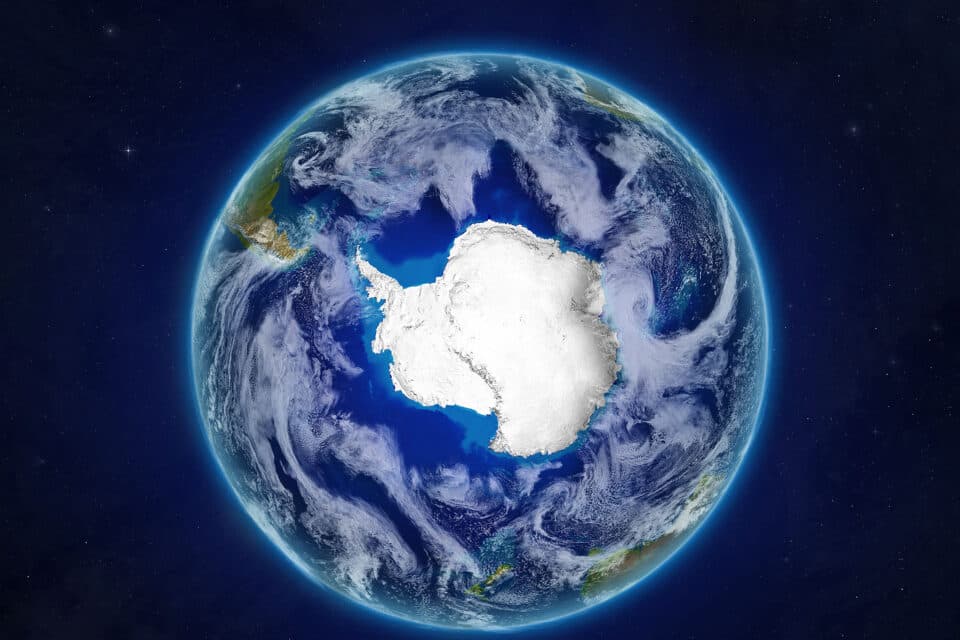The Antarctic Circumpolar Current (ACC) is the most powerful current on Earth, encircling Antarctica and influencing the global climate.
Over the last few decades, observations show that it has been speeding up. Experts were uncertain whether this was a result of human-caused warming or a natural pattern.
However, scientists have discovered that this oceanic powerhouse is getting even stronger. What does this mean for our planet’s future?
Ocean depths
An international team of researchers embarked on a daring expedition to remote, turbulent waters. The goal was to recover sediment cores containing millions of years’ worth of clues about the ACC’s behavior alongside Earth’s temperature changes.
Through meticulous analysis, the experts uncovered the secrets held within the layers of sediment.
Current, climate, and ice
The study reveals a strong link between the ACC’s speed and Earth’s overall temperature, much like a thermostat.
During colder periods, the current slowed down. But when the planet warmed up naturally in the past, the current responded by speeding up.
What’s truly alarming is that these past ACC speedups were directly connected to major losses of Antarctic ice. We’re observing a similar speedup of the ACC right now, driven by human-caused warming.
This suggests that Antarctica’s ice will likely continue to retreat – potentially fueling sea-level rise and even affecting the ocean’s ability to soak up carbon from our atmosphere.
Why Antarctic currents matter
“This is the mightiest and fastest current on the planet. It is arguably the most important current of the Earth climate system,” said Gisela Winckler, a geochemist at Columbia University’s Lamont-Doherty Earth Observatory.
ACC is a major player in Earth’s climate system, acting as a global conveyor belt that redistributes heat and nutrients across the world’s oceans.
Characteristics of the ACC
Vast scale: The ACC is the largest ocean current, stretching around Antarctica and connecting the Atlantic, Pacific, and Indian Oceans. It’s the only ocean current that encircles the globe completely, free from any continental barriers.
Volume and speed: It transports more water than any other current — approximately 135 million cubic meters per second. Its flow is influenced by wind patterns, the Earth’s rotation, and differences in water density.
Depth and width: The ACC extends from the surface to the ocean floor, reaching depths of up to 4,000 meters (about 13,123 feet) and spans widths of up to 2,000 kilometers (about 1,243 miles).
Functions of the ACC
Climate regulation: The ACC plays a crucial role in regulating the global climate. It helps distribute heat around the planet by moving warm water from the equator towards the poles and cold water towards the equator.
Carbon sequestration: The ACC is instrumental in the global carbon cycle. It absorbs significant amounts of carbon dioxide from the atmosphere, transporting it deep into the ocean where it can be stored for centuries.
Nutrient distribution: By stirring up water from different depths (upwelling), the ACC brings nutrients from the deep to the surface, supporting marine ecosystems around Antarctica and beyond.
Importance of the ACC
Biodiversity support: The nutrients brought to the surface by the ACC support phytoplankton blooms, which are the foundation of the Antarctic food web, sustaining a diverse array of marine life from krill to whales.
Impact on global ocean circulation: The ACC influences global ocean circulation patterns, including the formation of deep water masses in the North Atlantic that drive the global conveyor belt, a critical component of Earth’s climate system.
Climate change indicator: Changes in the speed or pattern of the ACC can indicate alterations in the global climate system. Its acceleration due to increased westerly winds is a concern, as it could have implications for sea-level rise and global temperature patterns.
The ocean’s influence on Antarctic current
How does the speeding up of the ACC affect things directly? Here’s how:
Melting Antarctica’s ice shelves
Winds over the Southern Ocean have grown about 40% stronger in the past few decades, driving the ACC and pulling warmer waters towards Antarctica’s floating ice shelves.
These shelves act like giant plugs holding back huge glaciers. The warmer water erodes them from below, causing melting.
“If you leave an ice cube out in the air, it takes quite a while to melt. If you put it in contact with warm water, it goes rapidly” explains Winckler.
Uncertain carbon sponge
The oceans around Antarctica are a vital component of the Earth’s carbon cycle. They absorb a substantial amount of the carbon dioxide (CO2) that humans emit into the atmosphere, roughly 40%, acting as a “carbon sponge.”
This process is critical in moderating global warming, as it removes CO2 from the atmosphere, where it would otherwise trap heat, contributing to the greenhouse effect.
Why ocean currents are important
Ocean currents play a crucial role in shaping the Earth’s climate and supporting marine ecosystems. These massive, continuous streams of water flow through the world’s oceans, transporting heat, nutrients, and organisms across vast distances.
Types of ocean currents
Two primary types of ocean currents exist: surface currents and deep water currents.
Surface currents, driven by wind patterns and the Earth’s rotation (Coriolis effect), flow in the upper 400 meters of the ocean.
Deep water currents, on the other hand, are driven by density differences caused by variations in temperature and salinity.
Antarctic and other ocean currents
Several major ocean currents significantly impact the Earth’s climate and marine life:
The Gulf Stream: This warm, swift current originates in the Gulf of Mexico and flows along the eastern coast of the United States before crossing the Atlantic Ocean towards Europe.
The Antarctic Circumpolar Current: As discussed in this article, this current connects the Atlantic, Pacific, and Indian Oceans, facilitating the exchange of water and influencing global climate patterns.
The Kuroshio Current: Also known as the Japan Current, this western boundary current in the North Pacific Ocean transports warm, tropical water northward, affecting the climate of Japan and the Korean Peninsula.
Impact on climate and marine life
Ocean currents regulate global climate by redistributing heat from the equator to the poles, moderating temperatures worldwide.
They also transport nutrients, plankton, and other organisms, supporting diverse marine ecosystems and fisheries.
As the Earth’s climate continues to change due to global warming, ocean currents may also undergo significant alterations.
Melting ice caps, rising sea levels, and shifting wind patterns can all influence the strength and direction of currents, potentially leading to far-reaching consequences for the planet’s climate and marine life.
Future of Antarctic current
“These findings provide geological evidence in support of further increasing ACC flow with continued global warming,” noted the researchers.
As humans continue to pump greenhouse gases into the atmosphere, it’s almost certain that the ACC will keep speeding up. This is likely to unleash more intense warming around Antarctica, further destabilizing the West Antarctic Ice Sheet.
This vast reservoir of ice, much of it below sea level, holds the potential to raise global sea levels dramatically.
It’s time to pay attention to Antarctic current
The ACC isn’t getting as much attention as rising temperatures or melting Arctic ice caps, but perhaps it should. This mighty current has a complex relationship with our planet’s climate system, and changes to it will have ripple effects worldwide.
Understanding these complex forces, along with reducing greenhouse gas emissions, is essential to prepare for a future where a sped-up ACC, rising seas, and extreme weather might reshape our world.
More about ocean currents
The study is published in the journal Nature.
Source: earth.com




